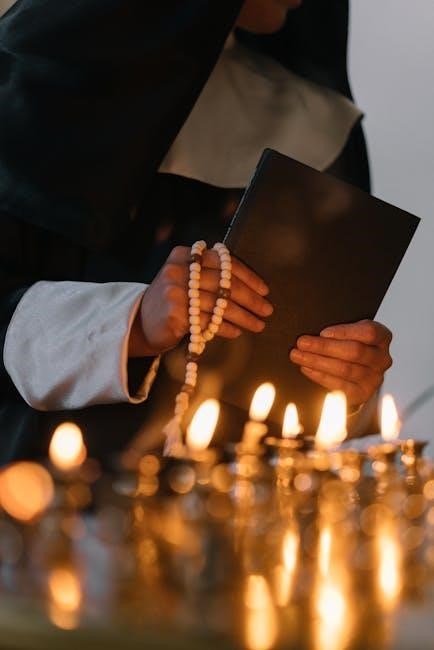The Divine Liturgy of St. John Chrysostom is a central worship service in the Eastern Orthodox Church, celebrated throughout the year. It combines prayer, scripture, and sacrament, emphasizing communion with God and unity among believers. This liturgy, attributed to St. John Chrysostom, reflects his profound theological insights and pastoral care, blending tradition with spiritual depth. Its structure includes the Liturgy of the Word and the Liturgy of the Faithful, culminating in the Eucharist. Widely used and revered, it embodies the richness of Orthodox worship, accessible through various resources, including PDF versions and English translations, ensuring its timeless relevance.
Overview of the Liturgy
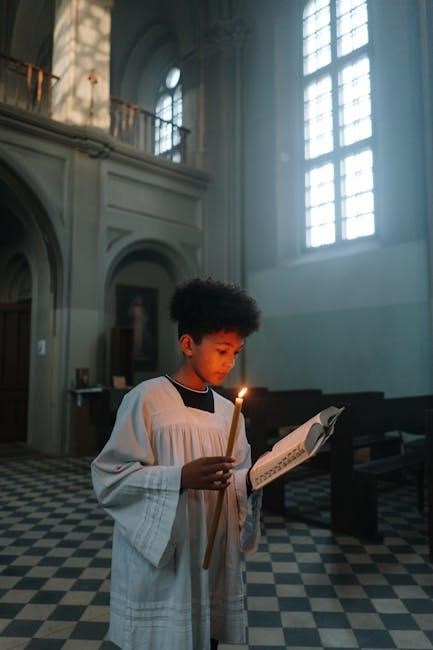
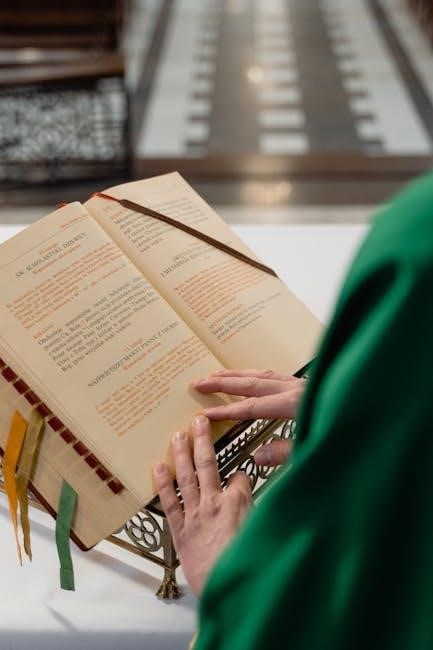
The Divine Liturgy of St. John Chrysostom is a cornerstone of Orthodox Christian worship, structured to guide believers through a spiritual journey. It begins with preparatory prayers and the Liturgy of the Word, which includes readings from Scripture and the recitation of the Nicene Creed. The Liturgy of the Faithful follows, focusing on the Eucharistic sacrifice. Central to this is the consecration of the bread and wine, believed to become the Body and Blood of Christ. The liturgy culminates in communion, where the faithful partake of the Eucharist, uniting with God and one another. Throughout, prayers, hymns, and liturgical actions create a rich tapestry of worship, emphasizing both individual devotion and communal fellowship. The liturgy is celebrated throughout the year, with slight variations for feast days and special occasions. Its structure and content reflect the deep theological and spiritual traditions of the Orthodox Church, making it a profound expression of Christian faith and practice.
Importance of St. John Chrysostom in Orthodox Worship
St. John Chrysostom holds a preeminent place in Orthodox worship, revered as a great preacher, theologian, and liturgical reformer. His Divine Liturgy, celebrated widely in the Orthodox Church, is a testament to his deep spiritual insight and pastoral care. Chrysostom’s liturgy is prized for its balance of theology and spirituality, emphasizing the mystery of the Eucharist and the unity of the faithful. His contributions to liturgical prayer and hymnography have shaped the worship life of the Church, making him a central figure in Orthodox tradition. The Church commemorates him as a champion of orthodoxy and a model of compassionate leadership. His relics are venerated, and his feast days are celebrated with special liturgical honors. The enduring influence of St. John Chrysostom is evident in the widespread use of his liturgy, which continues to inspire and nourish the faithful. His legacy bridges the ancient and modern, ensuring his relevance in contemporary Orthodox worship and devotion.

Historical Background of the Liturgy

The Divine Liturgy of St. John Chrysostom traces its origins to the 4th-5th centuries, evolving from earlier liturgical traditions. It became a standard in Orthodox worship by the 9th century, reflecting the rich spiritual and cultural heritage of the Byzantine Church.
Life and Legacy of St. John Chrysostom
St. John Chrysostom, a prominent early Christian Church father, was born in Antioch around 347 AD. Known for his exceptional preaching and theological wisdom, he became Archbishop of Constantinople in 398 AD. His name, “Chrysostom,” meaning “golden-mouthed,” reflects his renowned oratory skills. A fierce advocate for church reform, he criticized corruption and luxury within the clergy, leading to his exile and eventual martyrdom in 407 AD. His legacy endures as a Doctor of the Church, with his writings and sermons remaining influential. The Liturgy of St. John Chrysostom is a testament to his deep spiritual insight, blending prayer, scripture, and sacrament. Celebrated in Eastern Orthodox and Eastern Catholic Churches, it emphasizes communion with God and unity among believers. His feast day is commemorated on November 13, and the translation of his relics is honored on January 27/February 9. His contributions to liturgical worship continue to inspire devotion and theological reflection, with his liturgy widely accessible in PDF and translated formats for modern worshippers.
Development of the Liturgy Attributed to St. John Chrysostom
The Divine Liturgy of St. John Chrysostom is believed to have evolved from earlier liturgical traditions, with its final form attributed to St. John Chrysostom. While he likely refined existing practices, the liturgy reflects his theological depth and pastoral sensitivity. It incorporates elements from the Liturgy of St. Basil and other ancient rites, blending them into a cohesive worship service. The structure includes the Liturgy of the Word, with readings from Scripture, and the Liturgy of the Faithful, culminating in the Eucharistic prayer. Over centuries, the liturgy has been enriched by hymns and prayers, maintaining its core integrity while adapting to the spiritual needs of the faithful. Its development is a testament to the dynamic yet reverent approach of the Orthodox Church. Today, the liturgy remains a cornerstone of worship, accessible in PDF formats and English translations, ensuring its timeless relevance for modern congregations while preserving its ancient traditions.
Structure of the Divine Liturgy
The Divine Liturgy of St. John Chrysostom is divided into two main parts: the Liturgy of the Word and the Liturgy of the Faithful. It begins with prayers and hymns, followed by Scripture readings, the Eucharistic prayer, and communion. The structure emphasizes worship, fellowship, and spiritual renewal, with variable parts adapting to the liturgical calendar. The liturgy is celebrated by the priest and deacon, maintaining a balance between solemnity and joy, and is widely available in PDF and translated formats for universal accessibility.
Preparation for the Liturgy
Preparation for the Divine Liturgy of St. John Chrysostom involves both spiritual and physical readiness. The priest begins with private prayers, making three low bows before the altar and invoking the Holy Spirit. He prays quietly, “O heavenly King, O Comforter, the Spirit of truth, who art in all places and fillest all things; Treasury of good things and Giver of life: Come and dwell in us and cleanse us from every stain, and save our souls, O gracious Lord.” This prayer reflects the liturgy’s emphasis on purification and divine presence. The deacon, when present, assists in these preparations, ensuring the sacred vessels and space are ready. The congregation also prepares through fasting, prayer, and confession, fostering a spirit of repentance and communion. These preparations underscore the liturgy’s purpose: to unite the faithful with God and one another. The structure and prayers of the liturgy, as detailed in its PDF versions, highlight the importance of this preparatory phase in the worship experience.
The Liturgy of the Word
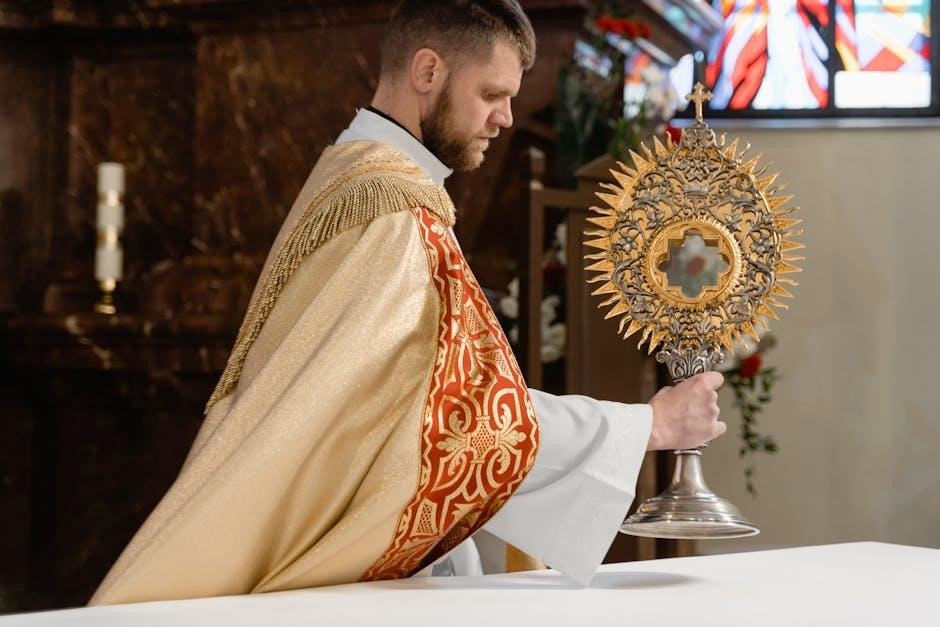
The Liturgy of the Word in the Divine Liturgy of St. John Chrysostom is a sacred dialogue between God and His people, focusing on the proclamation of Scripture and prayer. It begins with the priest’s invocation, “O heavenly King,” calling upon the Holy Spirit to guide the worship. The deacon then leads the congregation in petitions, seeking blessings for the Church, the world, and the faithful. The Epistle and Gospel readings follow, drawn from the New Testament, and are preceded by chants and prokeimena, emphasizing their spiritual significance. The priest delivers a homily or brief reflection, connecting the Scriptures to the lives of the faithful. This liturgical segment culminates in the recitation of the Nicene-Constantinopolitan Creed, affirming the Orthodox faith. The Liturgy of the Word prepares the congregation for the Eucharistic mysteries, fostering a deep sense of communal worship and spiritual renewal. Its structure and prayers, as outlined in the PDF versions of the liturgy, reflect the rich theological and liturgical heritage of the Orthodox tradition.
The Liturgy of the Faithful
The Liturgy of the Faithful is the second and most sacred part of the Divine Liturgy of St. John Chrysostom, focusing on the Eucharistic sacrifice and communion. It begins with the Great Entrance, where the priest carries the Holy Gifts (bread and wine) to the altar, symbolizing Christ’s journey to Golgotha. The choir chants the Cherubikon, emphasizing the heavenly nature of the liturgy. The priest then recites the Lord’s Prayer, invoking the Holy Spirit to consecrate the offerings. This is followed by the Anaphora, a solemn prayer recounting the Last Supper and Christ’s resurrection, culminating in the epiclesis, where the Spirit transforms the gifts into the Body and Blood of Christ. The faithful prepare for communion by reciting the Prayer of St. John Chrysostom, confessing their unworthiness and asking for mercy. The liturgy concludes with the distribution of Holy Communion, uniting the faithful with Christ. The structure and prayers of this section, as detailed in the PDF versions, highlight the mystical and transformative nature of the Eucharist in Orthodox worship.
The Consecration of the Eucharist
The Consecration of the Eucharist is the climax of the Divine Liturgy of St. John Chrysostom, where the bread and wine are transformed into the Body and Blood of Christ. The priest, acting in the person of Christ, recites the Anaphora, a prayer recounting the Last Supper and Christ’s resurrection. The epiclesis, a solemn invocation, asks the Holy Spirit to descend upon the Holy Gifts, transforming them. The faithful kneel in reverence as the priest elevates the chalice and paten, symbolizing the offering of Christ’s sacrifice. The Liturgy’s PDF versions detail these prayers, emphasizing the mystical union with Christ. This sacred moment is central to Orthodox theology, affirming the real presence of Christ in the Eucharist. The consecration culminates in the priest’s declaration, “Thine own of Thine own, we offer to Thee,” highlighting the Church’s offering of thanksgiving and sacrifice. The Eucharist is then ready for communion, uniting the faithful with God.
Communion and Dismissal
Communion and Dismissal mark the culmination of the Divine Liturgy of St. John Chrysostom, where the faithful partake of the consecrated Eucharist. The priest distributes the Holy Gifts, saying, “The Servant of God partakes of the Body and Blood of Christ.” The faithful approach reverently, crossing their arms, and receive communion as a means of spiritual nourishment and union with Christ. After communion, the priest offers a final prayer of thanksgiving, and the deacon leads the congregation in a prayer for the departed and the living. The liturgy concludes with the dismissal prayer, where the priest blesses the congregation, saying, “May Christ our true God have mercy on us and save us.” The service ends with the chanting of the dismissal hymn and the veneration of the cross or an icon, symbolizing the sending forth of the faithful to live out their faith in the world. PDF versions of the liturgy provide detailed texts for these final rites, ensuring their proper execution and spiritual significance.

Key Components of the Liturgy
The Divine Liturgy of St. John Chrysostom includes essential elements such as prayers, hymns, and the Eucharistic rite. The priest and deacon lead the congregation through sacred rituals, while the choir enhances worship with chanting. Symbolism, such as the use of incense and icons, enriches the spiritual experience, drawing believers closer to God.
Prayers and Hymns in the Liturgy
The Divine Liturgy of St. John Chrysostom is a tapestry of sacred prayers and hymns, creating a profound spiritual experience. The liturgy begins with the invocation of the Holy Spirit, as the priest prays, “O heavenly King, the Comforter, the Spirit of truth, who art in all places and fillest all things.” This prayer sets the tone for worship, inviting the Holy Spirit to dwell within the congregation. The Trisagion Hymn, “Holy God, Holy Mighty, Holy Immortal, have mercy on us,” is a cornerstone of the service, expressing reverence for the Trinity. The choir and congregation join in chanting, enriching the liturgical atmosphere. Eucharistic prayers, such as the Anaphora, are central, with the priest offering thanksgiving and consecrating the Gifts. Hymns like the “Cherubic Hymn” and the “Hymn to the Theotokos” deepen the mystical connection to heaven. These prayers and hymns, rooted in tradition, guide the faithful toward communion with God and unity with one another, embodying the liturgy’s timeless spiritual beauty.
The Role of the Priest and Deacon
In the Divine Liturgy of St. John Chrysostom, the priest and deacon play essential roles, guiding the congregation through worship. The priest leads the prayers, blesses the congregation, and performs the sacramental acts, such as the consecration of the Eucharist. He prays quietly before the altar, invoking the Holy Spirit, and proclaims key liturgical texts, like “Blessed is the Kingdom of the Father, and of the Son, and of the Holy Spirit.” The deacon assists the priest, chanting litanies, leading the congregation in prayer, and proclaiming the Gospel. When a deacon is absent, the priest assumes these responsibilities. Their collaboration creates a seamless worship experience, emphasizing unity and reverence. Both roles ensure the liturgy’s proper execution, fostering a spiritual connection between the faithful and God. Their leadership is vital to the liturgy’s structure and meaning, reflecting the Orthodox tradition of communal worship and sacramental life.
Symbolism in the Liturgical Rites
The Divine Liturgy of St. John Chrysostom is rich in symbolism, reflecting deep theological and spiritual truths. The invocation of the Holy Spirit, the preparation of the Eucharistic gifts, and the liturgical gestures all carry profound meaning. The priest’s three low bows before the altar symbolize humility and reverence, while the consecration of the bread and wine represents Christ’s sacrifice and resurrection. The liturgical chant and hymns, such as the Trisagion Hymn, emphasize the heavenly and eternal nature of worship. The deacon’s litanies and the priest’s blessings symbolize the intercession of the Church and the unity of the faithful. The Eucharistic prayer itself is a symbolic reenactment of the Last Supper, connecting the congregation to Christ’s redemptive act. These symbols create a sacred atmosphere, drawing worshippers into the mystery of salvation and fostering a deeper spiritual connection with God. The liturgy’s rich symbolism ensures that every action and word conveys the Orthodox faith’s core beliefs and spiritual aspirations.
Cultural and Theological Significance
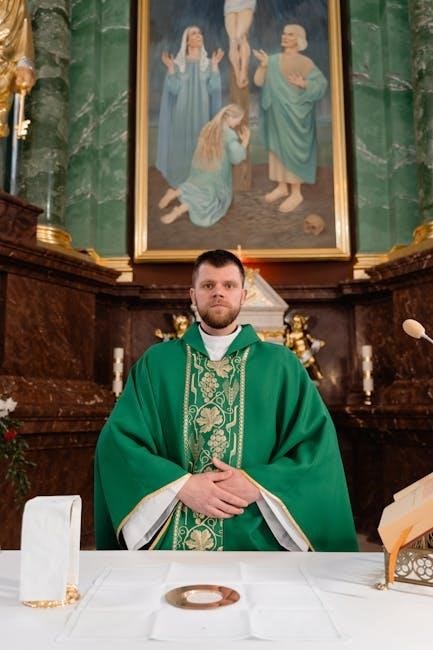
The Divine Liturgy of St. John Chrysostom holds profound cultural and theological significance, reflecting the spiritual richness of Eastern Orthodox Christianity. It embodies the Church’s tradition, uniting worshippers across time and space. The liturgy’s prayers and hymns, such as the Trisagion, express deep theological truths, while its structure mirrors the heavenly worship described in Scripture. It has inspired countless composers, including Rachmaninov, and remains a cornerstone of Orthodox identity. The liturgy’s emphasis on community, sacrament, and prayer fosters a vibrant spiritual life, making it a timeless treasure in Christian worship.
Influence on Eastern Orthodox Worship
The Divine Liturgy of St. John Chrysostom profoundly shapes Eastern Orthodox worship, serving as the primary liturgical rite for most Sundays and weekdays. Its structure and prayers, such as the Trisagion and the Eucharistic Canon, are deeply ingrained in Orthodox spirituality. The liturgy’s emphasis on communal prayer, sacramental participation, and the veneration of saints reflects the Church’s understanding of worship as a foretaste of heaven. It has inspired countless musical compositions, including works by Rachmaninov, and remains a cornerstone of Orthodox identity. The liturgy’s theological richness, particularly in its expression of the mystery of the Eucharist, continues to guide the spiritual lives of believers. Its influence extends beyond liturgical practice, shaping the Church’s devotional life and theological expression. As a testament to St. John Chrysostom’s legacy, the liturgy remains a vital expression of Orthodox faith and culture, uniting worshippers across generations and continents.
Comparison with Other Christian Liturgies
The Divine Liturgy of St. John Chrysostom stands as a cornerstone of Eastern Orthodox worship, distinct yet sharing common roots with other Christian liturgical traditions. Compared to the Roman Catholic Mass, it emphasizes a more mystical and communal experience, with a rich tapestry of prayers and hymns. While both traditions honor the Eucharist as the climax of worship, the Orthodox liturgy often incorporates more litanies and congregational participation. In contrast to Protestant liturgies, which may vary widely, the Chrysostom liturgy maintains a structured and sacramental focus. Its influence extends beyond Orthodoxy, with elements incorporated into Catholic and Anglican services. The liturgy’s musical adaptations, such as Rachmaninov’s compositions, further highlight its universal appeal. Despite these comparisons, the Liturgy of St. John Chrysostom remains uniquely rooted in Eastern Orthodox theology and practice, offering a profound expression of Christian worship that continues to inspire across traditions.
Resources and Accessibility
The Divine Liturgy of St. John Chrysostom is widely available in PDF formats, offering easy access for personal or communal use. English translations and digital platforms further enhance its accessibility, ensuring its timeless spiritual guidance reaches global audiences effectively.
PDF Versions of the Liturgy
PDF versions of the Liturgy of St. John Chrysostom are widely available online, providing convenient access for worship and study. These documents often include the full text of the liturgy, prayers, and hymns, making them ideal for personal devotion or communal use. Many Orthodox churches and organizations offer official PDF translations, ensuring accuracy and fidelity to the original Greek text. For example, the Byzantine Metropolitan Church Sui Juris of Pittsburgh has published an official English translation in PDF format, which is widely used. Additionally, websites like the Greek Orthodox Archdiocese of America (GOA) provide daily variable parts of the liturgy in PDF form, complementing the fixed portions of the service. These resources are easily downloadable and searchable, making the liturgy accessible to a global audience. The availability of PDF versions has significantly enhanced the ability of believers to engage with the liturgy, whether at home, in church, or on the go.
English Translations and Commentaries
English translations of the Liturgy of St. John Chrysostom are widely available, offering accessibility to non-Greek speakers while preserving the liturgy’s theological depth. The official English translation by the Byzantine Metropolitan Church Sui Juris of Pittsburgh, promulgated on January 6, 2007, is a prominent resource. This translation ensures fidelity to the original Greek text while making the liturgy understandable to English-speaking congregations. Additionally, the Greek Orthodox Archdiocese of America (GOA) provides English versions of the liturgy, including variable parts for daily use. These translations often include commentaries and explanations, enriching the spiritual experience of worshippers. Scholarly commentaries further explore the liturgy’s historical and theological significance, offering insights into its structure, prayers, and hymns. Such resources are invaluable for both clergy and laity, fostering a deeper understanding of the liturgy’s role in Orthodox worship. By balancing tradition and accessibility, English translations and commentaries ensure the liturgy remains a vibrant and meaningful part of Christian devotion.
Digital Platforms for Liturgical Study
Digital platforms have revolutionized access to the Liturgy of St. John Chrysostom, offering a wealth of resources for study and participation. Websites like the Greek Orthodox Archdiocese of America (GOA) and the Internet Archive provide PDF versions of the liturgy, enabling worshippers to follow the service digitally. These platforms often include the full text of the liturgy, including variable parts for specific feast days, making them indispensable for both clergy and laity. Additionally, digital libraries and Orthodox websites offer English translations, commentaries, and scholarly articles, fostering deeper understanding. Multimedia resources, such as audio recordings and video explanations, further enhance liturgical study. Many platforms also feature search functions, allowing users to explore specific prayers or hymns within the liturgy. These tools not only facilitate personal devotion but also support communal worship, ensuring the liturgy remains accessible and engaging in the digital age. By leveraging technology, these platforms preserve the tradition of St. John Chrysostom while making it relevant to modern worshippers.

Conclusion
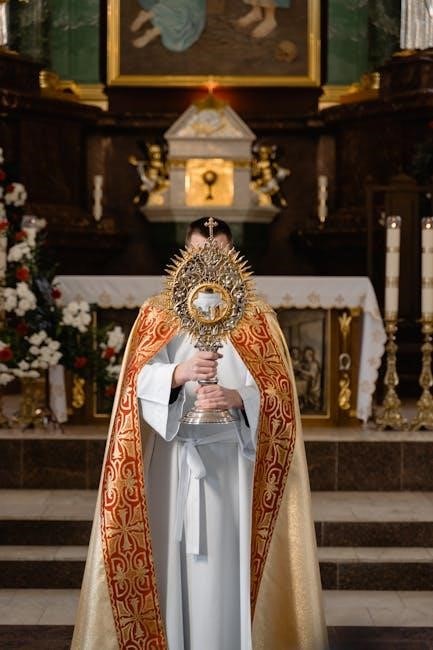
The Divine Liturgy of St. John Chrysostom remains a cornerstone of Orthodox worship, offering a profound spiritual experience that unites believers across generations. Its rich theological depth, combined with its accessibility through PDF versions and digital platforms, ensures its continued relevance in modern times. The liturgy not only honors the legacy of St. John Chrysostom but also serves as a living tradition that nourishes the faith of the Orthodox Church. By preserving the liturgy in various formats, the Church ensures that its teachings and prayers remain accessible to both scholars and the faithful. This timeless worship service continues to inspire spiritual growth, fostering a deeper connection to God and the Orthodox community. As technology advances, the liturgy adapts, yet its essence remains unchanged, a testament to the enduring power of Orthodox worship.
